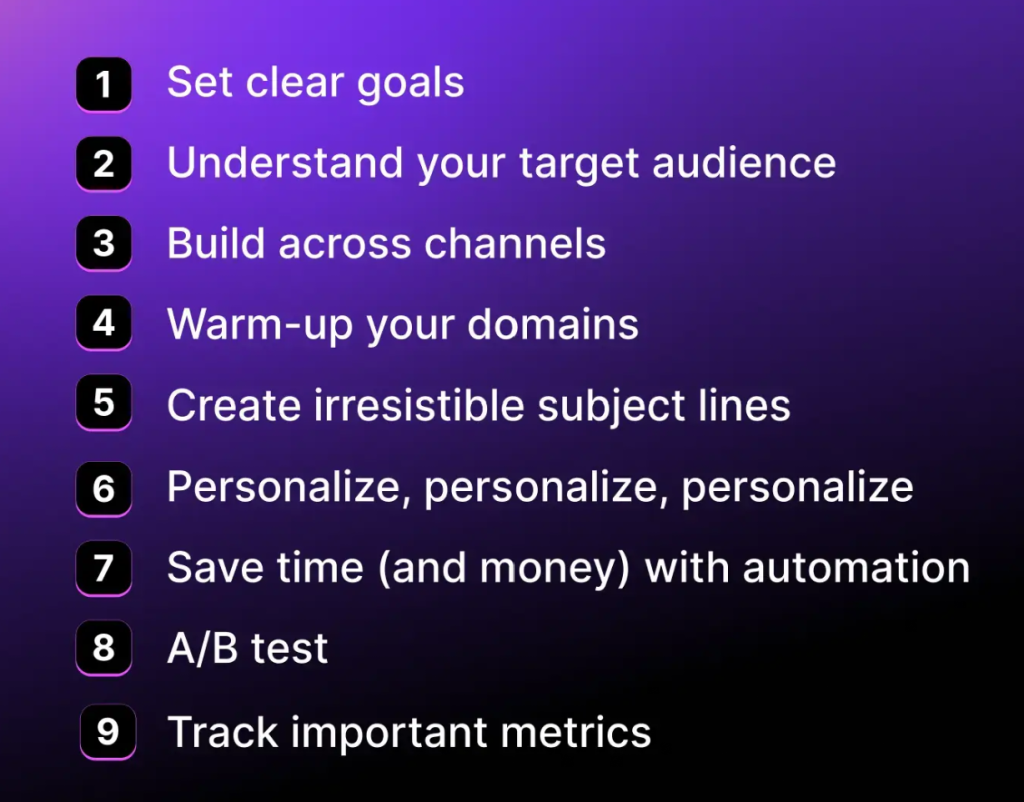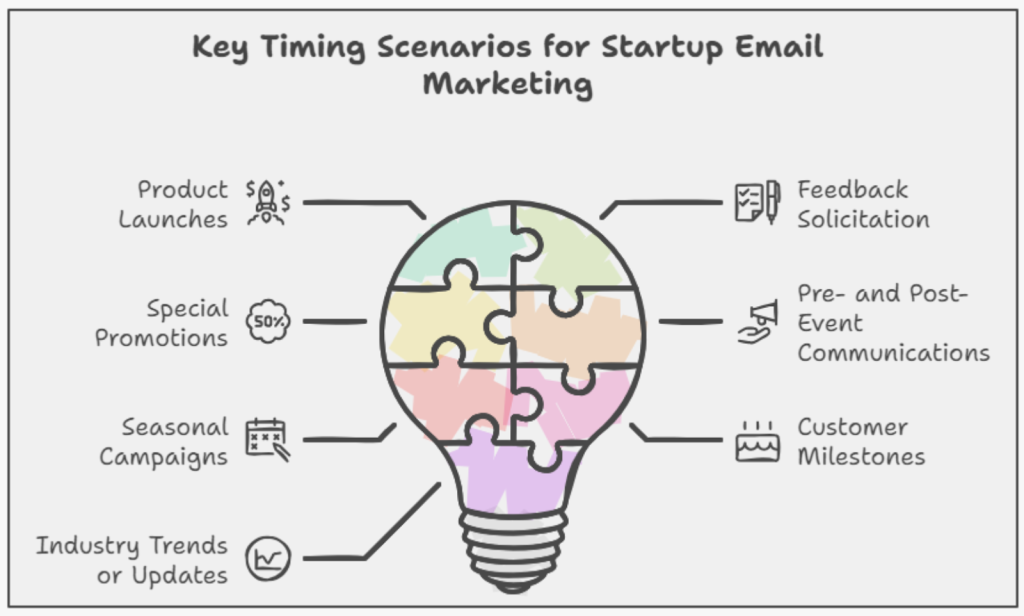- Home
- Targeted Tactics
- Email Marketing for Startups [ ...

Successfully running a startup with all its challenges, obstacles, and unique circumstances is often considered to be the equivalent of winning the lottery or getting a scholarship to Harvard. While it might be equally challenging to achieve those two feats, it can be equally rewarding as well.
In this article, we want to focus on one particular aspect of succeeding in the competitive startup environment: different startup email marketing strategies and building an email list for startups. Even more than established companies, startups often need to rely on low-budget marketing approaches and efficient ways to reach their customers (and to build a strong relationship with them).
Starting from zero, however, can make this challenging—so, we want to show you which email marketing mistakes startups should avoid and provide a few startup email campaign examples that should be on each startuper’s list.
Why Email Marketing Is Crucial for Startups
✨ Cost-efficiency and scalability as the business grows
Many startups have budgets that vary between “limited” and “almost none.” It makes founders count every dollar. The same reason makes email campaigns so attractive to startups: they are inexpensive to create, easy to automate, and scalable. So, what starts as a simple newsletter to 50 subscribers can eventually grow into advanced startup email marketing strategies and reach thousands without drastically increasing costs.
✨ Email marketing is a high-ROI channel
Study after study confirms that email outperforms most other channels when it comes to return on investment. When resources are limited, email marketing for startups becomes one of the smartest investments—it consistently delivers results without requiring heavy spending on advertising.
✨ Direct channel vs. dependence on social media algorithms
Social media is something you can’t fully control, as their policies change and algorithms shift. With email, it’s different. You own your list, not Meta or Google. That’s why conversations about how to build an email list for startups often begin even before a product launch—as once built, it makes it a channel you can fully own and rely on.
✨ Relationship building with early adopters
Your early subscribers are the people who believe in your idea before the rest of the world does. And it is totally up to you to turn them into loyal supporters—again, with email marketing. Write a simple welcome email, a founder’s note, or even just a quick update. By making them sound real and honest, you’ll be halfway towards winning their loyalty.
✨ Data and feedback that guide growth
Every campaign you send gives you something back—open rates, clicks, replies. These email metrics that marketers should know are valuable signals that show you what your audience is interested in and where you can adjust. For a startup that is still figuring things out, this feedback is even more valuable.
✨ Built-in adaptability
Email grows with you. In the beginning, it might be just one newsletter a month, but later you can add segmentation of email lists, automated follow-ups, and behavior-based campaigns. The system expands with your startup. The only thing to remember is not to lose that personal tone your audience liked from the start.
Building Your First Email List from Scratch
💎 Website strategies (sign-up forms, exit popups, gated content)
Your website is usually the first touchpoint people have with your startup, so it makes sense to start building your email list there. A simple sign-up form on your homepage already works great. Similarly, exit popups can catch those who are about to leave, while gated content (a short guide, checklist, or even a sneak peek of your product) can give people a reason to leave their email.
💎 Using events, webinars, and product waitlists
If your startup hosts online events, product demos, or even small webinars, don’t miss the chance to collect emails. People who show up already have interest in what you’re doing, so asking them to join your list feels natural. The same goes for product waitlists. A “Join the waitlist” button creates excitement, but it also gives you a warm list of people ready to hear from you the moment you launch.
💎 Startup-specific incentives (beta invites, founder updates, exclusive deals)
Startups have something unique that big brands often don’t. This something is direct access to the founder and the feeling of being part of something new. Use that. Offer beta invites, behind-the-scenes updates, or small exclusive perks. These things don’t need to be expensive—they are the core idea behind a startup. In fact, sometimes just saying “be the first to know” is enough to spark curiosity.
💎 Compliance basics (GDPR/CCPA simplified)
When building your list, you also need to respect the rules. Regulations like the GDPR and CCPA may sound intimidating, but in practice, it’s about being transparent and fair. Always get clear permission, tell people what they’re signing up for, and make it easy for them to unsubscribe. See compliance as a trust signal, and trust is one of the most valuable things your startup can build early on.
💎 Best practices for startup email marketing

Must-Have Email Campaigns for Startups
⭐ Welcome email/series
The first email you send to a new subscriber sets the tone for the rest of your campaign (true not only for start ups). That’s why a welcome email or even a short series is a must-have. What do you usually say in a welcome email? Tell your brand story, explain your value proposition, and simply show what makes your startup different. For many subscribers, exactly this first touchpoint decides whether they will keep opening your emails further.
⭐ Product updates
Startups move fast, and your subscribers shall feel as a part of that journey. Product updates are a simple way to keep them engaged and informed about your progress. These updates help subscribers see how your product is evolving and decide how well they fit into your story. For a young company, these updates are proof of momentum, and they can easily become part of your core startup email marketing strategies.
⭐ Behind-the-scenes founder notes
One of the big advantages startups have over established brands is the founders’ proximity to users. A short email directly from the founder creates a certain type of a more profound bond. To make it work—make it feel honest. The more honest it sounds, the more powerful it will be.
⭐ Community-building campaigns
Your early adopters often want more than just product news—they want to belong. By inviting them to join, for example, a small beta testing group, you can create a sense of community around your startup. These campaigns make people feel like insiders, which strengthens loyalty. For many founders, this, in fact, is the first step towards building a true brand community.
Email Marketing Analytics for Startups
⭐ Track the metrics that matter when you’re early-stage
When you’re just starting out, it’s easy to get lost in numbers. Dashboards throw dozens of data points at you, but most of them don’t matter yet. At the beginning, focus on the basics: open rate shows if your messaging makes people curious enough, click-through rate tells you if your offer is compelling, and conversion rate answers the most important question—does your product actually solve a problem? These are the foundational email metrics that marketers should know, and they’re more than enough to guide you when you’re still early-stage.
⭐ A/B test subject lines and CTAs to learn fast without burning budget
You don’t need a big marketing budget to figure out what works. A simple A/B test—two subject lines, two CTAs—can already show you what your audience prefers. It’s one of the easiest forms of low-budget marketing for startups, because you learn fast, spend little, and apply those insights right away.
⭐ How to set realistic benchmarks (don’t compare with big brands)
A common mistake is comparing your numbers to those of established companies. Their lists are bigger, their budgets are bigger, and their audience profiles are completely different. Startups need to measure progress against themselves. If your open rate climbs over time or your conversions slowly improve, that’s your win. Email marketing for startups is not about hitting industry averages on day one but about building a good foundation and making improvements step by step.

Email Marketing Mistakes Startups Should Avoid
⚠️ Buying email lists
It might feel like a shortcut, but it’s one of the worst things you can do. It damages your sender reputation before you even begin, and that is a rule every marketer needs to learn early on. A startup (or any other company) buying email lists will spend more time fixing the damage than gaining value.
⚠️ Overemailing your small audience
In the early days, your email list is usually small, and that makes it tempting to send every little update. But overwhelming subscribers with too many emails quickly leads to unsubscribes (do not forget about email fatigue). It’s better to focus on sending fewer, more meaningful messages that keep your audience curious and engaged.
⚠️ Neglecting segmentation
Your investors, beta testers, and paying customers all have different needs. So, why should they get the same message? Sending one generic campaign to everyone is a fast way to lose them all. Even basic segmentation of email lists goes a long way in making your communication more meaningful.
⚠️ Forgetting the mobile experience
Most of your early users will check emails on their phones. If your emails aren’t mobile-friendly, you’re losing them at the hello stage. For startups, which are considered more advanced than established brands, ignoring mobile design is one of those mistakes that shall be avoided at all costs.
To Sum Up
In this article, we’ve tried to show you which things matter for developing a strong email marketing strategy for startups. The competitive environment in which many startups operate, combined with the inherent uncertainty of the startup landscape, can make it rather hard to develop a good email marketing strategy. However, we hope that this article has managed to show both the typical must-have email campaigns for startups and why it’s necessary to invest time in them.
Build more than a startup—build an ecosystem with clients that actually care about not only your product, but your startup as a whole.



